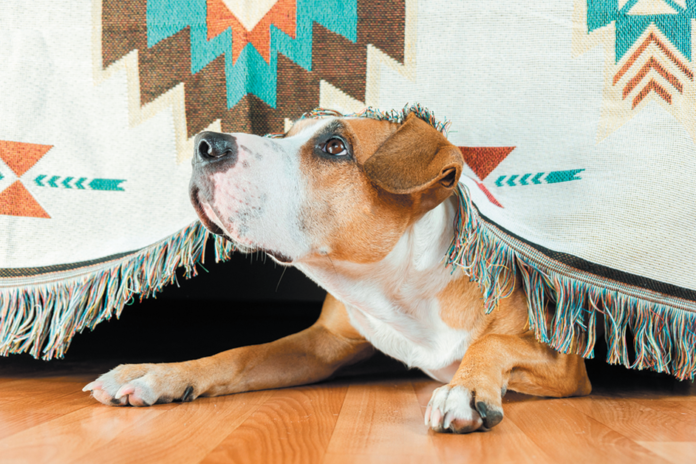Staring, aggression toward family members, excessive drinking…. No, we are not talking about your in-laws. We’re talking about people’s dogs, yours included.
A study on almost 14,000 pet dogs found that so many suffer from anxiety-induced behaviors and compulsions that it appears the large majority of our pets are afflicted with stress that significantly impacts the quality of their lives. The subjects represented 264 types of purebreds in addition to mixed breeds, showing that worry and fear are equal-opportunity emotions among our canine friends.
For instance, just about one in three of all the dogs exhibited some kind of noise sensitivity, while almost the same proportion had various fears, ranging from fear of other dogs (exhibited by one in six dogs) to fear of novel situations, walking on metal grates or shiny floors, and moving from one kind of surface to another. Heights were another fear trigger for some canines, especially when they had to cross narrow bridges, walk next to glass railings, or climb stairs.
The above-mentioned staring, aggression toward family members, and excessive drinking (of water) were not as prevalent but were part of a number of anxious behaviors, such that 72.5 percent of all the dogs were somehow afflicted — almost three in four. Other problems included compulsions such as self-biting and snapping at imaginary flies and behaviors related to separation anxiety, including barking, panting, and salivating. Impulsivity and inattention were up there, too, perhaps suggesting that some dogs can’t settle down or pay attention to things going on around them because they remain in too agitated a state.
The researchers, from Finland’s University of Helsinki, say it isn’t just a matter of quality of life. They point to previous research that suggests anxious dogs may be more vulnerable to diseases and a decreased lifespan.
They conducted their research by combing through comprehensive questionnaires filled out by respondents throughout Finland. The questionnaire consisted of seven major categories of canine-related anxiety traits that were then broken down into sub-traits. For instance, “aggression” could be aggression toward other dogs, aggression toward strangers, or aggression toward family members.
Particularly telling findings
Interestingly, the prevalence of noise sensitivity increased with age — something to watch for as your pet matures. This was especially true for fear of thunder, but we have also had people tell us their aging dogs could no longer take the sound of such things as the roar of a crowd in a stadium when family members were watching sports on television. If your dog starts whining, pawing at you, or retreating when certain sounds occur, see if you can comfort him by turning off the sound or, if not, perhaps by taking him to a room (like a finished basement) where it may be more muffled.
The type of anxiety can depend on the breed
One in nine miniature schnauzers was aggressive toward strangers, the highest proportion among any of the breeds. But it was not to strut their stuff. The researchers point out that fearful dogs were more than three times as likely to exhibit aggression as non-fearful dogs, reflecting the common view among animal behaviorists that aggression is not about ruling the roost but about a dog’s sense that she must use extreme measures to protect herself in the face of perceived danger. Other breed highlights:
- Wheaten terriers exhibited a relatively high degree of noise sensitivity.
- Shetland sheepdogs were found to have a disproportionate share of fear in general.
- Rough collies (the kind who look like Lassie) were most apt to have a fear of surfaces and heights.
- Border collies were most likely to engage in snapping imaginary flies.
Such results suggest that while environment can play a role in worried or neurotic behaviors or reactions, they are to some degree genetically baked in. The researchers suggest that breeders work to reduce the incidence of breed-associated stress behaviors through careful mating of dogs that don’t exhibit the undesirable traits.
They also found that certain traits appear linked. For instance, impulsive behavior is highly correlated with separation anxiety. It’s what scientists call a comorbidity — when one health problem exists together with another. Humans have related comorbidities, too. Attention deficit hyperactivity disorder (ADHD) and obsessive-compulsive behavior frequently go together in people, for instance — and so it may be possible to tease apart some of what goes on in people’s psyches that can be disruptive by looking at the same or similar linked traits in dogs.
Bottom line
Perhaps the most important message to take away from the research is that dogs have their issues, just like we do. And just like with us, it could be the result of their genes, their environment, or the influence of one upon the other. Whatever the reason(s), we need to be compassionate toward our dogs and accommodate their fears or simply remove them from their anxiety triggers. Nobody — not dogs, not people — can calm down and begin to get over their issues if others keep showing them that their worries are annoying and causing their caretakers to lose patience.






My sweet rescue dog Oliver, yawns all the time. I’ve heard that dogs yawn to relieve stress. Does this mean that Oliver is stressed most of the time even though he is dearly loved and my best friend?